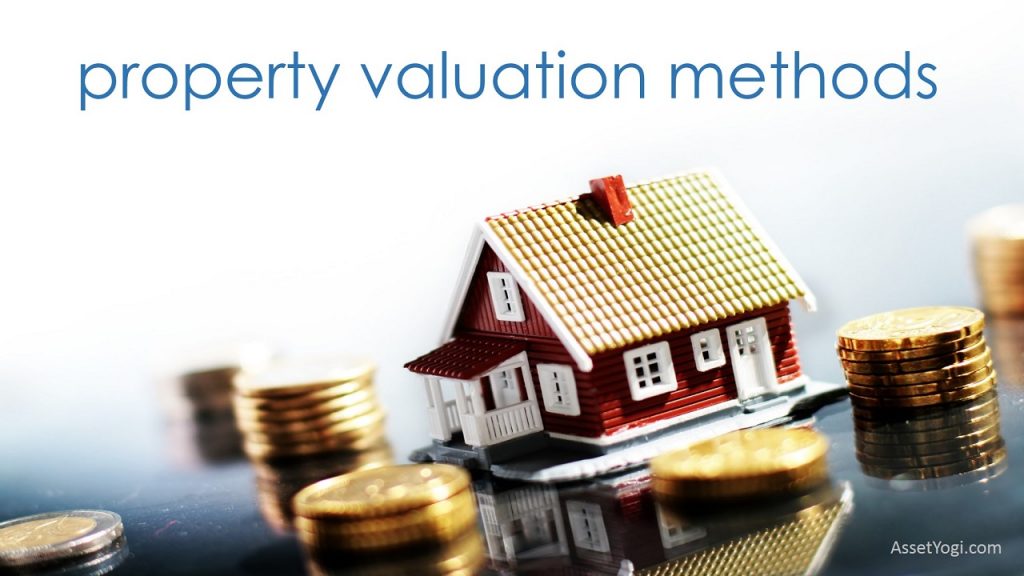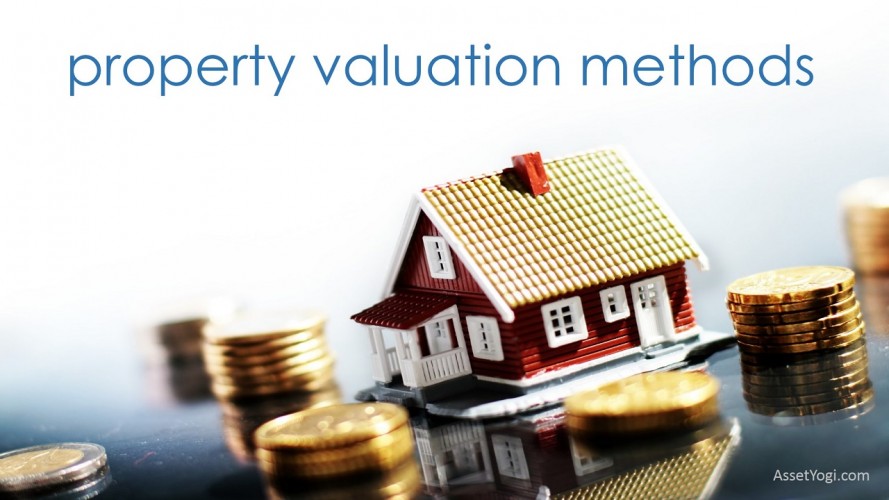Property Valuation is the technique of estimating and determining the fair market value of a property. There are various property valuation methods available for valuing land, residential, commercial and industrial properties.
Valuation of property depends upon many factors such as location, type of property, size, shape, frontage, connectivity, infrastructure, economic development etc. In this article, we discuss about various property valuation methods generally used by professional valuation experts. Depending on the type of information available, you can choose any of the property valuation methods discussed below.
Before we discuss property valuation methods, let us first understand different situations when we need valuation of property.
Purposes of Property Valuation
Some of the major reasons for which you would need to do a property valuation are:
1. Buying or Selling Property
While buying or selling a property you would require the right valuation of property.
2. Taxation Purposes
Property valuation is required to assess capital gains tax, property tax, wealth tax, municipal tax etc.
3. Rent Value
Lease rent is generally calculated as a percentage of the property value. It ranges between 6-10% of capital value of property. Hence, you need to value the property correctly.
4. Loans or Mortgage
Banks will first value the property independently and then sanction loan upto maximum 80% of property value.
5. Compulsory Acquisition
Whenever a property is acquired by law, compensation is paid to the owner based on fair valuation of property.
6. Insurance
Property valuation is also required to determine the insurance premium of a property.
7. Calculation of Stamp Duty
While registering a property, stamp duty is calculated as a percentage of the property value. It varies across states and generally ranges from 4-10% of property value.
8. Visa Requirements
While applying for visa to a country, you need to show your net worth. You may be required to produce property valuation report along with the visa application.
9. Personal Purposes
You may require property valuation for division of property, during legal cases related to property and many other personal reasons.
In addition to the above you may have to do valuation of property for many other reasons. Now, let us see various property valuation methods.
Property Valuation Methods
Determination of Cost of Building
1. Accounts method
In this method, value of building is assessed based on the material and labor costs taken in books of accounts, provided all accounts are supported by authentic vouchers and receipts. In case, vouchers for some materials are not available, the cost for same is estimated and added at market rates. Similarly, labor cost is estimated based on payment accounts and factoring for any gaps in such payments. If accounts are maintained properly by a builder, this method yields accurate results in building valuation.
2. Plinth Area Rate and Cost Index Method
This method is used when cost of a standard building is known. From the total cost of building, Plinth Area Rate (PAR) is calculated by dividing the total cost by total area of the building. The extra cost in providing richer specifications compared to the standard building, whose plinth area was determined, is added to the basic cost to arrive at the completion cost. You can use standard Plinth Area Rates for various types of buildings as made available by CPWD (Central Public Works Department) and State PWD. These rates are then adjusted using Cost Index to factor in the inflation.
3. Detailed or Item Wise Method
In this method, quantities of all items of work are separately calculated. Thereafter, their unit rates are determined and the cost is calculated for each item. This method is applicable only when detailed construction drawings or completion drawings are available.
In case, standard schedule rates are followed then suitable cost index should be applied to make the rates up to date. When detailed drawings and other details are available, this method should be preferred over other methods.
4. Material and Labor Contract Method
This method is used when the owner arranges for materials partly or fully and the work is executed on labor contract. Again, you can use labor rates as published by CPWD or State PWD. The final cost is arrived by adding costs of material supplied by owner and the cost of labor & any material supplied by the contractor. Any design and consultancy charges should also be suitably added to the cost.
5. Comparative Method
For valuation of properties like Flats/ Shops/ Offices in multistoried buildings, comparative method can be used. In order to arrive at the unit rates of built up properties most comparable with the property under consideration, you would need to make suitable adjustments to factors such as location, situation, area, floor difference, specifications, facilities, time-gap, floor disposition etc.
Determination of Fair Market Value of Property
1. Land and Building Method
As the name indicates, in this method the value of land is added to the value of building to arrive at the fair market value of the property. The method is generally adopted in the following situations:-
(a) In the case of self-occupied property.
(b) In the case of property partly self-occupied (i.e. more than 60%) and balance tenanted.
(c) In the case where it is not possible to obtain fair and maintainable rent.
(d) In case where there is no direct evidence of rent such as schools and hospitals etc.
(e) In the case where the property is not fully developed, or the return from the property is not commercial.
Check out our article on Land valuation methods to understand how to value land. Building valuation can be done by using any of the methods discussed above. While valuing the building, you need to factor the depreciation due to the building’s age and obsolescence.
2. Comparative Method
Comparative Method is a popular method for valuation of property. It involves comparing similar types of properties in a given area to judge the value of any particular property. In order for this method to be truly effective, it is necessary to know the exact sales price of properties, rather than available asking prices online. Asking prices can however give an indication on the market value of property. Also, while valuing a property using comparative method, you should collect as much sales data as possible and calculate the average price over last 2-3 years. If you rely only on a couple of recent sales, you may not get accurate results. For eg. a forced or pressure sale may highly undervalue a property while on the other hand a property owner who wants to buy an adjacent property may value the property a little higher than its market value.
Once, you get an average price for a similar property in the vicinity, you need to adjust the price for following factors: Size, Shape, Level, Frontage & Depth, Return Frontage, Accessibility, Floor Space Index (FSI), Infrastructure & Development, Nature of Soil, Encumbrances or any special features. To know more about these features, read our article on Land Valuation.
3. Capitalization Method
3.1 Rent Capitalization Method
This method is generally used in the following situations:
(a) In case the land is fully developed i.e. it has been put to full legally permissible and economically justifiable use and the income out of the property is normal commercial and not a controlled return or a return depreciated on account of special circumstances.
(b) In the case of fully tenanted property with proper rent/ lease agreements
(c) In the case of a property small portion of which is self-occupied and balance large portion is tenanted.
(d) In the case of commercial establishment like cinemas and hotels, if the building is given on outright lease / rental basis and rent fetched is reasonable.
The Fair Market Value can be expressed by the basic formula:
V = I/R, where
“V” is the present value of future right to rental income.
“I” is the annual Net Maintainable Rent which is the difference between Gross Maintainable Rent and Out Goings,
“R” is the Rate of Capitalization.
3.2 Repayment Method
A simplified version of Rent Capitalization Method is Repayment Method. In repayment method, the investor estimates the value of property with an aim that the income from property would repay the price within 12-15 years. So, the value of property can be calculated by the formula:
V = I x P, where
“V” is the value of property,
“I” is the annual Net Maintainable Rent which is the difference between Gross Maintainable Rent and Out Goings, and
“P” is the repayment period in years
In both Rent Capitalization Method and Repayment Method, outgoings include repair & maintenance costs, insurance costs, municipal taxes, ground rent (in case of leasehold property), operating expenses etc.
4. Development Method
This method of valuation is generally used for large parcel of land in the following situations:
(a) When the comparable sales of large parcels of land are not available but sales of small plots are available,
(b) When the land can be used to develop a residential, commercial or industrial property
To determine fair market value of land using development method, following steps should be taken:
- Ascertain the demand for small plots in the area.
- Deduct area required for infrastructure like roads, drainage, parks, utilities etc. and open areas from total land area. Generally, it works out to 25 to 40% of the total area.
- Determine the number of small plots which can be legally carved out from the large tract of land with necessary provisions for infrastructure facilities.
- Determine cost of development works, say (C).
- Determine the total Income (I) that can be generated by selling smaller plots after deducting suitable marketing and administrative expenses.
- Estimate developer’s profit (D)
- Now, the fair market value of the land is (I) – (D) – (C).
5. Profit Method
In the case of Hotels, Motels, Cinemas, Public houses which fall under the category of the licensed premises, the fair market value depends primarily on the earning capacity of the property. The fair market value of such properties is determined by applying profit method provided:
(i) The owner runs Hotel, Cinema himself.
(ii) The owner outsources Hotel or Cinema property to an operator by signing an operating agreement.
The fair market value of the property is determined by capitalizing the net profits at certain rate of expenses, owners risk and other outgoings from the gross income.
6. Guideline Value
In order to ascertain the value of the property for the purpose of stamp duty, property tax, wealth tax etc. government publishes guideline values for relevant period, location and type of property i.e. land, residential, commercial and industrial property. These guideline values are available online on various state and central government websites. In some states, the guideline values are also known as circle rates.
Final Word
Before you decide to adopt a property valuation method, you should first analyze the information available. Then you should authenticate all information about the property by conducting a physical site visit. Then depending on the information and its authenticity, you can apply one or more of the above property valuation methods to determine fair market value of the property.
Over to You
We need your love! Like and Share this article on “Property Valuation Methods – Valuation of Property Decoded”, if you found it useful.
Have something to say or ask? Please comment below.



